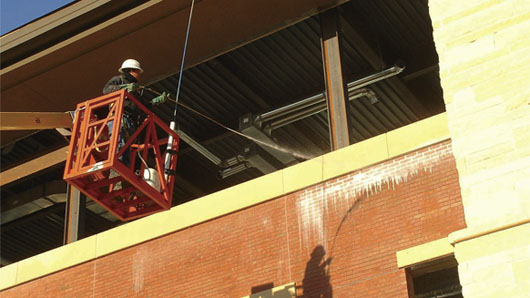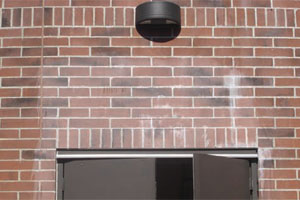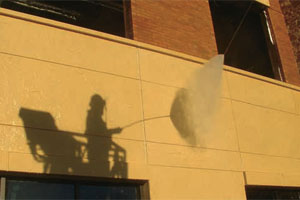June 23, 2009 8:19 AM CDT

Getting in your house or car without the keys can be tough. Cleaning masonry architecture, new or old, without one or more of the three, simple keys to successful masonry cleaning can be devastating.
The keys are:
To cut costs, the mason contractor had forced the cleaning contractor – over the cleaning contractor’s objections – to use muriatic acid to remove excess mortar and common jobsite soiling.
The problem wasn’t mere unsightliness, explains Jim Lucas, architectural consultant, J.N. Lucas and Associates, Hammond, Ind. The muriatic acid had eaten the joints to such an extent that they were no longer weather resistant.

An elementary school in Akron, Ohio, with a concrete brick exterior, looked fine after its new-construction cleaning in 2007 – for about three weeks.
That’s when the rich, deep red of the concrete brick faded to a dull, listless pink. To save time, the contractor had applied the cleaner at pressures six- to eight-times the manufacturer’s recommended maximum.
The high pressure jammed the cleaner into the concrete brick pores to a depth of 1/8- to 1/4-inch, says Mike Trotta, contractor training specialist for PROSOCO in Lawrence, Kan. That was too deep for rinse water to flush out. Later, as the embedded cleaner effloresced out of the brick, it faded the color. Though the concrete brick, a good product, was not to blame, it’s now banned from the Akron school system, Trotta says.
The clay brick front and split-face block sides all looked terrific after post-construction cleaning in 2008. But the rear of the building, also split-face block, was scarred with wand marks.
The project superintendant explained what happened, Lucas says. Though the super had cleaned the building’s sides personally, he’d let an inexperienced apprentice clean the back without proper supervision. Wand marks resulted.
In this case, and the other two, the damage was at least partly reversed. But the cost in time, money, reputation and aggravation could have – and should have – been avoided altogether.
That crucial info is often supplied on a pallet tag on every masonry cube. If not, manufacturers will usually be glad to give you their recommendations on request. It’s in their interests, as well as yours, to have projects look as beautiful as you can make them.
Choosing the right restoration cleaner is harder. The staining and soiling probably started before you were born. It’s hard, and it’s thick. It’s often made of multiple contaminants. The surface in the grip of these stains may be sensitive, damaged or decayed. A cleaner that’s right for the soiling but wrong for the substrate could give you clean, but damaged masonry.
Craig Christensen, a project manager with Sparklewash Construction Services, an Omaha, Neb., masonry cleaning contractor, has a simple answer for that problem.
“I get a rep from the manufacturer of the cleaning products I’m interested in to come to the site for no-cost tests,” Christensen says. “That way, I always know right from the beginning that I’ve got the right cleaner – and procedure. If the manufacturer can’t send a rep, I find one who can. It’s not worth it to take a chance.”

It’s no secret that masonry professionals would rather lay masonry than clean it. That doesn’t make cleaning any less crucial. If you don’t want to clean the brick yourself, consider hiring a professional, and then following that professional’s recommendations.
Though the job might not be fun, it’s far too important to the building’s final appearance – and price tag – to trust it to anyone without the proper training and qualifications.
“Our apprentices work on simple cleaning jobs under supervision,” Christensen says. “It’s part of their training. But complicated jobs like restoration cleaning, and mixed and sensitive masonry jobs, are only for our most skilled foremen.
“They know the details that make jobs turn out right, like using plenty of water to pre-wet and rinse,” he says. “They know not to get in too tight with the wand.”
“He’d gotten away with that before,” Trotta explains. “Even though the cleaner instructions warn specifically not to apply at high pressure, the contractor thought he could save time. And, he did, on a few jobs where the walls were dense clay brick and tooled mortar joints. He took an awful chance, but was lucky. His luck ran out when he encountered the porous concrete brick.”
Instructions on reputable masonry cleaning products tell you specifically what kind of equipment to use, right down to the nozzle size, Trotta says. Successful masonry cleaners follow the instructions.
The cleaning sub-contractor on the Akron elementary school was an experienced professional with an effective cleaner. But the wrong application equipment sank him.
The kid who left the wand marks had good equipment and a good cleaner. But without experience or supervision, he was in a position to do some damage, and he did.
While two out of three may be okay for coin flips, you need all three keys to succeed in masonry cleaning.
When you have them, there’s not much that can stop you.
Three Keys to Successful Masonry Cleaning
By Gary Henry

This photo shows why you should always test before overall cleaning. Here, a contractor tested a cleaner made for clay brick on concrete brick. Photo courtesy of Mike Trotta/PROSOCO.
Getting in your house or car without the keys can be tough. Cleaning masonry architecture, new or old, without one or more of the three, simple keys to successful masonry cleaning can be devastating.
The keys are:
- The correct cleaner
- The proper personnel
- The right equipment
Incorrect Cleaner
It was a multi-million-dollar luxury home on the north side of Chicago. The exterior was red brick and gray mortar – except that the mortar joints weren’t gray. They’d turned to an ugly yellow after new-construction cleaning in 2008 with muriatic acid. The raw acid had eaten away the cement paste, exposing yellow sand.To cut costs, the mason contractor had forced the cleaning contractor – over the cleaning contractor’s objections – to use muriatic acid to remove excess mortar and common jobsite soiling.
The problem wasn’t mere unsightliness, explains Jim Lucas, architectural consultant, J.N. Lucas and Associates, Hammond, Ind. The muriatic acid had eaten the joints to such an extent that they were no longer weather resistant.
Wrong Equipment

This photo shows why you should always test before overall cleaning. Here, a contractor tested a cleaner made for clay brick on concrete brick. Photo courtesy of Mike Trotta/PROSOCO.
That’s when the rich, deep red of the concrete brick faded to a dull, listless pink. To save time, the contractor had applied the cleaner at pressures six- to eight-times the manufacturer’s recommended maximum.
The high pressure jammed the cleaner into the concrete brick pores to a depth of 1/8- to 1/4-inch, says Mike Trotta, contractor training specialist for PROSOCO in Lawrence, Kan. That was too deep for rinse water to flush out. Later, as the embedded cleaner effloresced out of the brick, it faded the color. Though the concrete brick, a good product, was not to blame, it’s now banned from the Akron school system, Trotta says.
Personnel Problem
A strip mall in Wausau, Wis., looked great, on three sides.The clay brick front and split-face block sides all looked terrific after post-construction cleaning in 2008. But the rear of the building, also split-face block, was scarred with wand marks.
The project superintendant explained what happened, Lucas says. Though the super had cleaned the building’s sides personally, he’d let an inexperienced apprentice clean the back without proper supervision. Wand marks resulted.
In this case, and the other two, the damage was at least partly reversed. But the cost in time, money, reputation and aggravation could have – and should have – been avoided altogether.
Correct Cleaner
What’s the right cleaner for any given masonry? On a new-construction project, the masonry manufacturer will be glad to tell you. It’s an increasingly common practice for manufacturers to have their products tested by an independent lab to see which cleaners work best.That crucial info is often supplied on a pallet tag on every masonry cube. If not, manufacturers will usually be glad to give you their recommendations on request. It’s in their interests, as well as yours, to have projects look as beautiful as you can make them.
Choosing the right restoration cleaner is harder. The staining and soiling probably started before you were born. It’s hard, and it’s thick. It’s often made of multiple contaminants. The surface in the grip of these stains may be sensitive, damaged or decayed. A cleaner that’s right for the soiling but wrong for the substrate could give you clean, but damaged masonry.
Craig Christensen, a project manager with Sparklewash Construction Services, an Omaha, Neb., masonry cleaning contractor, has a simple answer for that problem.
“I get a rep from the manufacturer of the cleaning products I’m interested in to come to the site for no-cost tests,” Christensen says. “That way, I always know right from the beginning that I’ve got the right cleaner – and procedure. If the manufacturer can’t send a rep, I find one who can. It’s not worth it to take a chance.”
The Proper Personnel

Project Foreman Eduardo Erazo, Sparklewash Construction Services, Omaha, Neb., thoroughly flushes spent cleaner and dissolved contaminants from limestone after new-construction cleaning at the Bank of West Omaha. Photo courtesy of Craig Christensen, Sparklewash Construction Services.
Though the job might not be fun, it’s far too important to the building’s final appearance – and price tag – to trust it to anyone without the proper training and qualifications.
“Our apprentices work on simple cleaning jobs under supervision,” Christensen says. “It’s part of their training. But complicated jobs like restoration cleaning, and mixed and sensitive masonry jobs, are only for our most skilled foremen.
“They know the details that make jobs turn out right, like using plenty of water to pre-wet and rinse,” he says. “They know not to get in too tight with the wand.”
The Right Equipment
This is nothing more than the old common-sense adage “the right tool for the right job.” As the contractor at the Akron elementary school found out, using high-pressure spray equipment to apply a cleaner that should go on at low pressure was not “using the right tool for the right job.”“He’d gotten away with that before,” Trotta explains. “Even though the cleaner instructions warn specifically not to apply at high pressure, the contractor thought he could save time. And, he did, on a few jobs where the walls were dense clay brick and tooled mortar joints. He took an awful chance, but was lucky. His luck ran out when he encountered the porous concrete brick.”
Instructions on reputable masonry cleaning products tell you specifically what kind of equipment to use, right down to the nozzle size, Trotta says. Successful masonry cleaners follow the instructions.
Two Out of Three
The cleaning sub-contractor on the Chicago luxury home was a good man, with good equipment. But two out of three keys wasn’t enough.The cleaning sub-contractor on the Akron elementary school was an experienced professional with an effective cleaner. But the wrong application equipment sank him.
The kid who left the wand marks had good equipment and a good cleaner. But without experience or supervision, he was in a position to do some damage, and he did.
While two out of three may be okay for coin flips, you need all three keys to succeed in masonry cleaning.
When you have them, there’s not much that can stop you.
About the Author
Gary Henry is a business communication specialist with PROSOCO, a national manufacturer of products for cleaning, protecting and maintaining masonry, concrete and stone. For more information, contact Gary Henry at 785-830-7343, or e-mail ghenry@prosoco.com.


















